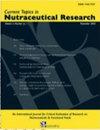组蛋白抑制牙周炎患者牙周膜细胞凋亡及内质网应激
IF 0.4
4区 医学
Q4 NUTRITION & DIETETICS
Current Topics in Nutraceutical Research
Pub Date : 2023-10-09
DOI:10.37290/ctnr2641-452x.21:339-345
引用次数: 0
摘要
在牙周炎中,内质网应激的增加伴随着牙周韧带细胞的凋亡和细胞死亡,进一步加剧了牙周组织的破坏。中药Hispolon可减轻过度氧化引起的细胞死亡。然而,其在牙周炎氧化应激和细胞凋亡中的作用尚不清楚。为此,在牙周炎细胞模型中,我们评估了增加组蛋白的剂量对逆转脂多糖引起的牙周韧带细胞活力增加的影响。结果显示,组蛋白对牙周韧带细胞的活性有剂量依赖性的促进作用。与脂多糖单独处理组相比,组蛋白处理组细胞凋亡减少,内质网应激(激活转录因子4、葡萄糖调节蛋白78和C/ ebp同源蛋白)和炎症(肿瘤坏死因子-α、白细胞介素-18和白细胞介素-6)水平降低。为了进一步研究其潜在的机制,我们测量了牙周韧带细胞中细胞外调节蛋白激酶磷酸化和Jun n -末端激酶磷酸化的相对表达。结果表明,组蛋白蛋白通过使丝裂原激活的蛋白激酶信号通路失活,减轻了脂多糖诱导的内质网应激和细胞凋亡的抑制作用。综上所述,组蛋白蛋白可减轻牙周炎患者的内质网应激,减轻牙周韧带细胞凋亡,其保护机制可能与丝裂原激活的蛋白激酶信号通路失活有关。本文章由计算机程序翻译,如有差异,请以英文原文为准。
Hispolon Suppresses Endoplasmic Reticulum Stress and Apoptosis of Periodontal Ligament Cells in Periodontitis
In periodontitis, increased endoplasmic reticulum stress followed by apoptosis and cell death in periodontal ligament cells further exacerbates periodontium destruction. Hispolon, a traditional Chinese medicine, could attenuate cell death induced by excessive oxidation. However, its role in oxidative stress and apoptosis in periodontitis is still unclear. To this end, the effect of the increasing dosage of hispolon on the reversal of the increase in cell viability caused by lipopolysaccharide in periodontal ligament cells in a periodontitis cell model was evaluated. The results show a dose-dependent hispolon promotion of cell viability in periodontal ligament cells. Cells treated with hispolon exhibited a decrease in cell apoptosis and a reduction in endoplasmic reticulum stress (Activating Transcription Factor 4, Glucose-Regulated Protein 78, and C/EBP-homologous protein) and inflammation (tumor necrosis factor-α, Interleukin-18, and Interleukin-6) levels than the lipopolysaccharide alone group. To further investigate the underlying mechanism(s), the relative expression of phosphorylation of extracellularly regulated protein kinases and phosphorylation of Jun N-terminal kinase in periodontal ligament cells were measured. The results show that hispolon attenuated lipopolysaccharide-induced inhibition of endoplasmic reticulum stress and apoptosis by deactivating the mitogen-activated protein kinase signaling pathway. In conclusion, hispolon reduces endoplasmic reticulum stress and alleviates apoptosis of periodontal ligament cells in periodontitis, and the protective mechanism is associated with the deactivation of the mitogen-activated protein kinase signaling pathway.
求助全文
通过发布文献求助,成功后即可免费获取论文全文。
去求助
来源期刊
CiteScore
1.10
自引率
0.00%
发文量
36
审稿时长
>12 weeks
期刊介绍:
Current Topics in Nutraceutical Research is an international, interdisciplinary broad-based peer reviewed scientific journal for critical evaluation of research on chemistry, biology and therapeutic applications of nutraceuticals and functional foods. The major goal of this journal is to provide peer reviewed unbiased scientific data to the decision makers in the nutraceutical and food industry to help make informed choices about development of new products.
To this end, the journal will publish two types of review articles. First, a review of preclinical research data coming largely from animal, cell culture and other experimental models. Such data will provide basis for future product development and/or human research initiatives. Second, a critical evaluation of current human experimental data to help market and deliver the product for medically proven use. This journal will also serve as a forum for nutritionists, internists, neurologists, psychiatrists, and all those interested in preventive medicine.
The common denominator of all of the topic to be covered by the journal must include nutraceuticals and/functional food. The following is an example of some specific areas that may be of interest to the journal. i) Role of vitamins, minerals, antioxidants and phytonutrients on cardiovascular health, cancer, diabetes, ocular health, mental health, men’s health, women’s health, infant nutrition, ii) Role of herbals on human health, iii) Dietary supplements and sleep, iv) Components of diet that may have beneficial effect on human health, v) regulation of apoptosis and cell viability, vi) Isolation and characterization of bioactive components from functional foods, vii) Nutritional genomics, and viii) Nutritional proteomics.

 求助内容:
求助内容: 应助结果提醒方式:
应助结果提醒方式:


